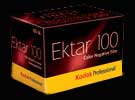
Kodak Ektar 100 review / evaluation
Tech data Kodak Ektar 100 pro
|
||||||||||||
|
 |
Light Source |
KODAK WRATTEN Gelatin Filter |
ISO Speed |
Daylight or Electronic Flash |
None |
100 |
Photo lamp (3400 K) |
No.80B |
32 |
Tungsten (3200 K) |
No.80A |
25 |
Daylight
Use the exposures in the table below for average front lit
subjects from 2 hours after sunrise to 2 hours before sunset.
Lighting Conditions |
Shutter Speed (second) and Lens Opening |
| Bright or Hazy Sun on Light Sand or Snow |
1/125 - f/16 |
| Bright or Hazy Sun (Distinct Shadows) | 1/125 - f/11* |
| Weak, Hazy Sun (Soft Shadows) |
1/125 - f/8 |
| Cloudy Bright (No Shadows) | 1/125 - f/5.6 |
| Heavy Overcast or Open Shade‡ 1/125 | 1/125 - f/4 |
Adjustments for Long and Short Exposures
No filter correction or exposure compensation is required
for exposures from 1⁄10,000 second to 1 second. For critical
applications with longer exposure times, make tests under your conditions.